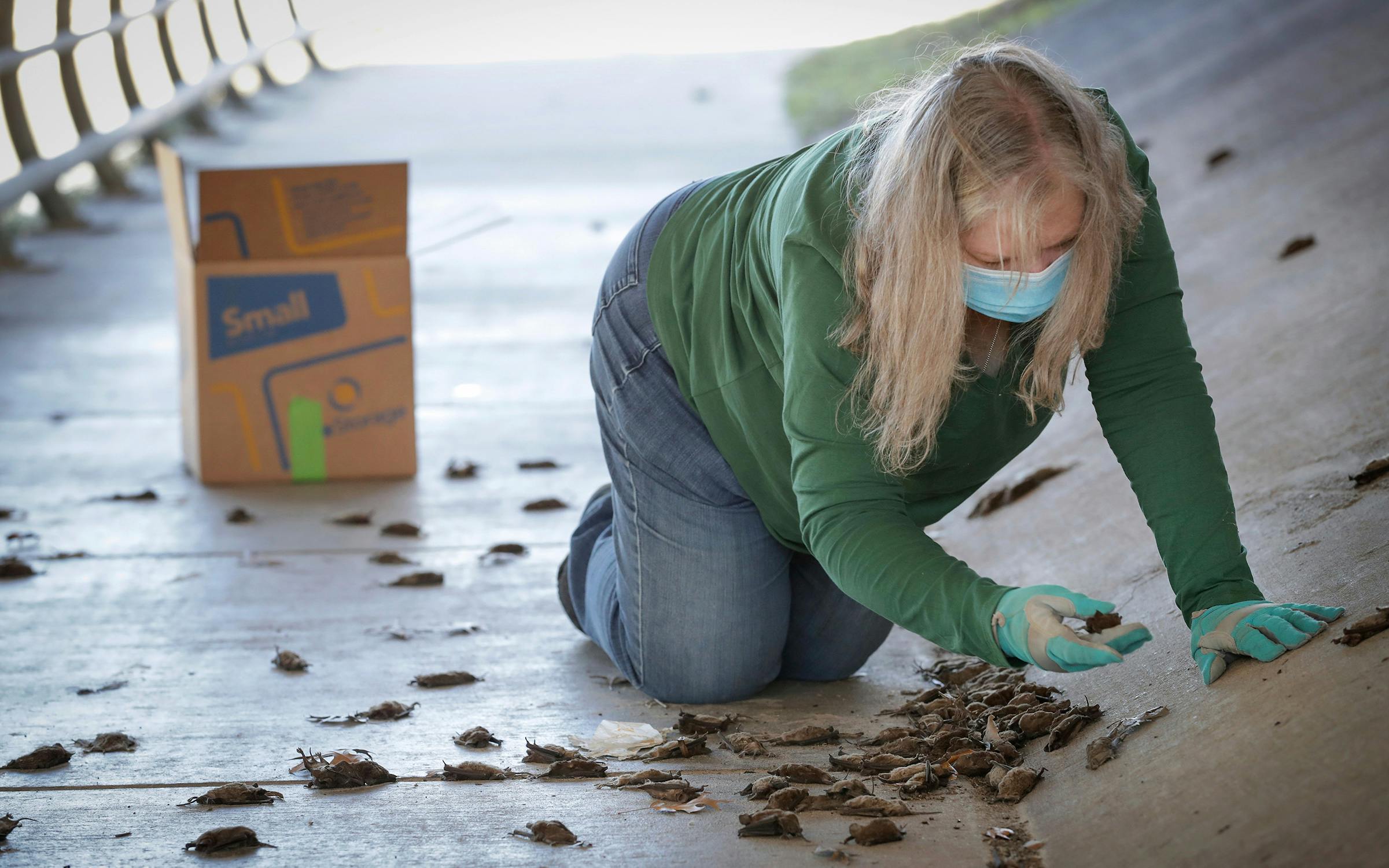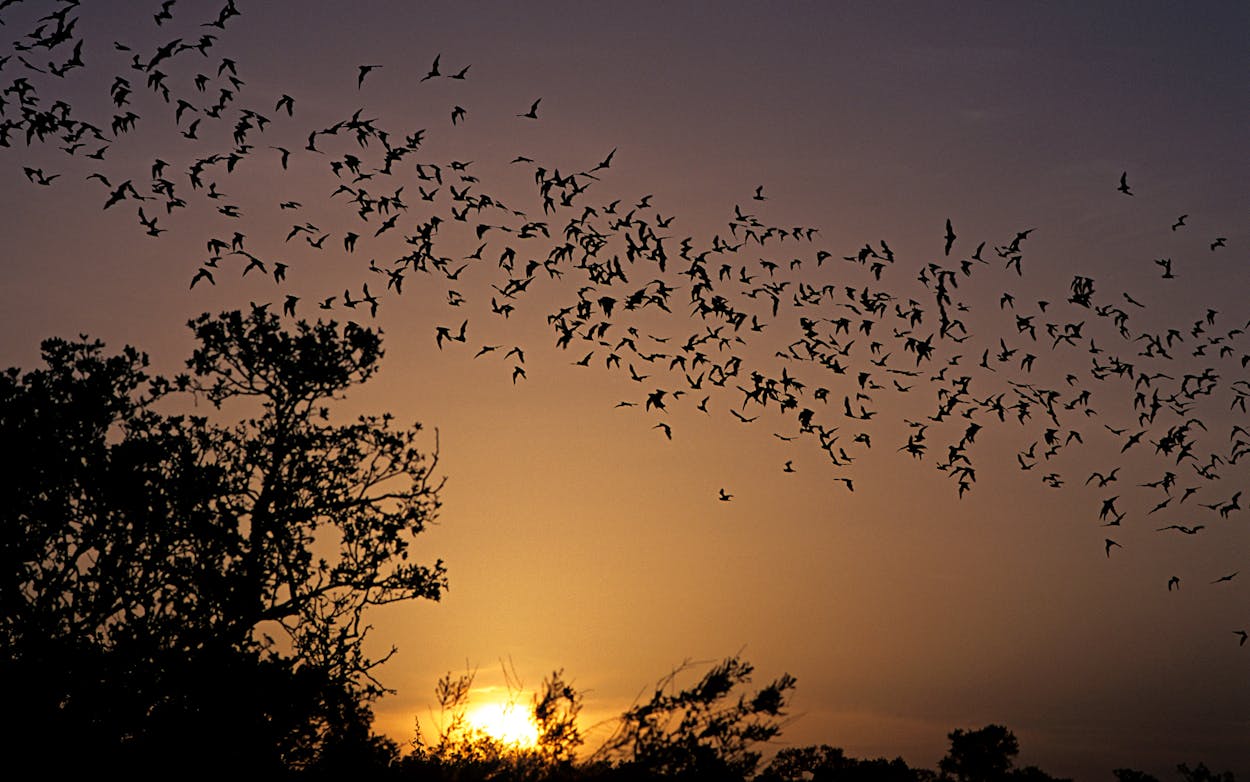No one knows yet just how many bats were killed by the frigid conditions of last month’s disastrous winter storm in Texas. Reports popped up across the state about thousands of the winged mammals found either dead or dying. The hardest-hit species appears to have been Mexican free-tailed bats, migrants better suited for warmer climates, as well as some species of yellow bats. But we may not know the full scope of the death toll for quite some time, if we ever do—partly because of a quirk in bat physiology.
“Bats have tendons attached to their claws such that just by hanging weight on them, it locks them in place,” says Merlin Tuttle, a biologist and executive director of Austin-based Merlin Tuttle’s Bat Conservation. “A bat once it dies may continue to cling to its perch for days or even weeks afterward because it takes a conscious effort for the bat to release.”
It’ll also be months before we have a sense of the larger ecological impact of this die-off. What will it mean this summer for the insect populations on which bats prey? Are humans more likely to be munched upon by a deluge of mosquitoes, without enough bats around to keep them in check? The answer is complicated—and goes far beyond mosquitoes—but the short answer is no, the loss of so many bats won’t significantly affect the number of tiny flying bloodsuckers. That’s not for the reason you might think, however, and there remain other significant environmental concerns.
Bat rescue groups and Texas Parks and Wildlife are doing what they can to mitigate the damage. Dianne Odegard and Lee Mackenzie, cofounders of Austin Bat Refuge, have set up field hospitals—tents with heating pads—to accommodate bats from throughout Central Texas. All told, 1,200 of the 3,700 bats they brought in were still alive, but they’ve released only 415. The rest likely won’t make it.
“We have quite a few where their wings look beautiful, but for some reason they can’t or won’t fly,” Odegard says. Mackenzie added that it’s been a “grueling week or two but now seems to be getting back to normal.”
It’s not clear from what exactly those incapacitated bats are dying. Michael Smotherman, a biologist at Texas A&M University, speculated that they could have suffered frostbite or nerve damage due to the cold.
“The problem with these bats, unfortunately for them, is that they’re used to dealing with one or two nights of freezing temperatures,” Smotherman says. “Because it went five to seven days, they just weren’t equipped to handle that. One or two days wouldn’t have been enough to get them to leave.”
Bats have two ways of staying warm through cold snaps. They can huddle together to share body heat for short periods, but if the cold persists, they enter a torpid state similar to hibernation. Their metabolism slows down, allowing their body temperature to drop to the ambient temperature, and they wait it out.

“We use most of our metabolic energy to maintain our body temperature, so if you shut down the need to have a high body temperature, you basically don’t have any need to burn any fat,” says Nate Fuller, a bat biologist for Texas Parks and Wildlife. “For an animal that generally has a very high metabolic rate, this is like a physiological superpower that can prevent them from needing too much energy.”
When the air temperature remained below freezing for days on end during the winter storm, the bats had to burn through their fat just to keep their body temperature a few degrees above freezing. They were stuck: if they broke their torpor, they wouldn’t have the energy to fly to somewhere warmer and they couldn’t forage because insects were affected by the freeze too. Bats get most of their water and all of their energy from insects, so many of the deaths were likely from dehydration or starvation, Fuller says.
Some of the bats that survived through the most frigid days might still have died as a result of being left without enough energy to forage. “Bats have an active body temperature of roughly 102 Fahrenheit,” Tuttle says. “Even after the severest cold passed, if they’re roosting in concrete crevices, these bats have to crank up a huge amount of energy to warm up to a temperature that would enable effective flight to go hunting, and they’re having to do it while the concrete is keeping them relatively cool.” Even those able to take to the air again faced the prospect of finding relatively few insects available to eat in the storm’s immediate aftermath.
The number of bats killed was likely increased by the fact that many migratory bats had already returned from their wintering in more southerly climes. February is early for migratory bats to return to Texas for the spring and summer, but Fuller says some began arriving around February 9 this year. Pregnant females often return first to seek a choice spot as a maternity roost, and most of the dead bats Fuller has encountered were female.
“It’s been such a mild winter that it made sense. They’ve been coming back earlier and earlier every year, and it’s usually not a big deal,” he says. “There have never been ten days of subfreezing temperatures they have to deal with. It’s just not something they’re physiologically prepared for.”
Fortunately, the cold didn’t affect the state’s—and the world’s—largest population. Bracken Cave outside San Antonio is home to some 15–20 million bats during the summer and has about 100,000 that stay over the winter, according to Fran Hutchins, director of Bat Conservation International’s Bracken Cave Preserve. The cave’s temperature doesn’t fall below 60 degrees Fahrenheit in the winter, so there haven’t been any fatalities because of the cold there.
As for the summer mosquitoes to come, Fuller is coming clean. “It’s one of the things that I hate to do as a bat biologist, but I’ve decided this year that I’m going to start telling people the truth about this,” he says. “As a bat biologist, we do like to perpetuate the myth that bats eat a lot of mosquitoes. The fact is that they don’t. Put yourself in the position of a bat: would you rather eat a big fat moth or a beetle, or would you rather eat a tiny, leggy mosquito?”
Bats will eat mosquitoes if they’re right in front of them, Smotherman says, but mosquitoes just don’t provide enough energy for them to actively hunt. Still, bats play a vital ecological role and how that will be affected this year by an unprecedented weather event remains an open question.
“They do eat moths and beetles, and those eat all our crops, so bats provide an almost immeasurable service to us in pest control and save farmers billions of dollars in pesticide use,” Fuller says. “While I do hate to admit that bats don’t eat mosquitoes, they eat a load of other creatures that are really bad for us, so they do provide us services that we care about.”
For instance, bats can eat almost up to their body weight in moths each night, Tuttle notes. “Let’s say a bat catches twenty of these moths, and moths are estimated to carry five hundred to one thousand eggs each,” he says. “That’s enough to force a farmer to spray multiple acres of crop with pesticide at a cost of seventy-four dollars per acre. That’s the potential impact of one bat in one night.”
Fuller expresses confidence that Texas bats will meet the state’s pest control needs this year, especially since moth populations and other insect larvae may also have been affected by the cold.
“These are the gigantic, immeasurable questions that we deal with all the time in biology that everyone wants to know the answer to,” Fuller says. “Lots of very smart people think about this a lot, but it’s really hard to measure the complexity of nature.”
The sort of climate change made apparent by the polar vortex that settled upon Texas, and much of the United States, last month will likely continue to pose one more threat to bat populations. Others, such as wind turbines, white nose syndrome, and the destruction of their habitat are taking their toll more gradually—compared with the mass deaths of February—but the losses can quickly add up.
“With the pregnant female bats, if you lose one bat, you lose two, and bats are slow reproducers. They only have one baby a year,” Hutchins says. “Any changes to the impact of the population over time can be significant. If you lose a season of babies and that happens a couple of times, the population can start to fall apart.”
Correction: This article originally misstated the temperature inside the Bracken Cave during the winter. It’s typically in the 60s degrees Fahrenheit.
- More About:
- Critters
- Winter Storm 2021






